The NZXT Kraken Z63 & X73 AIO Cooler Review: Shiny On Top, Solid Underneath
by E. Fylladitakis on August 19, 2020 11:00 AM ESTTesting Results, Maximum Fan Speed
Our maximum speed testing is performed with both the fans and the pump of the kit powered via a 12V DC source. This input voltage should have the pump and fans matching the speed ratings of the manufacturer. NZXT states that the 120 mm fans of the X73 have a rotational speed of 2000±300 RPM and the 140 mm fans of the Z63 a speed of 1800±300 RPM. What really stands out from these specifications is the very high-speed tolerance – a >15% tolerance definitely is not common amongst quality products. According to our tachometer, the 120 mm and 140 mm fans were rotating at about 1870 RPM and 2120 RPM respectively, well within their rated specifications. There were some speed differences between identical fans but these did not exceed 100 RPM, which is a little high but not dramatic.

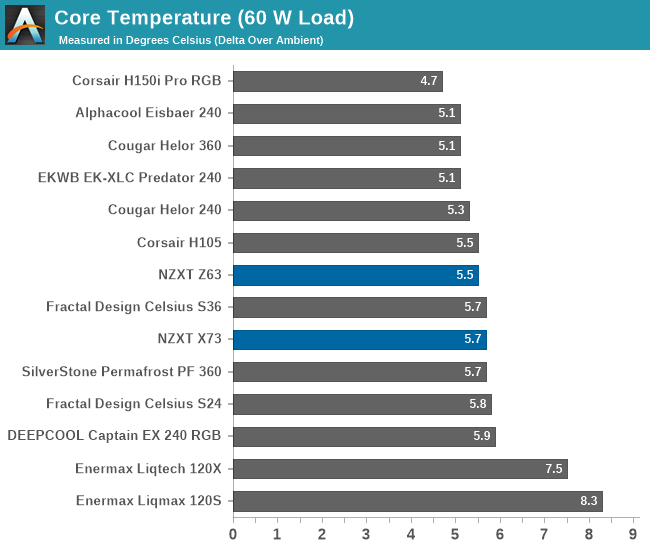
| Core Temperature, Constant Thermal Load (Max Fan Speed) |
The NZXT X73 stands out in our charts, as it manages to overtake every other similarly-sized AIO cooler that we have tested to this date. It has an average thermal resistance of 0.0719 °C/W, which is very good, but that comes with a sound pressure level of 42.9 dB(A), a figure that is definitely on the high side when compared to other, similar solutions. Although the X73 seems to be falling slightly behind when the thermal load is low, it is very efficient when having to cope with high loads, making it one of the best AIO coolers for handling large thermal loads.
Meanwhile the Z63, despite the use of 140 mm fans, falls behind in terms of cooling performance. With an average thermal resistance of 0.0751 °C/W, the Z63 performs well enough, but its thermal performance is fairly close to other coolers with smaller 240 mm radiators; so the Z63's extra size doesn't seem to be helping it much. Past this, like the X73, the Z63 does not stand out when the thermal load is low, but it is significantly more efficient when the thermal load is very high.
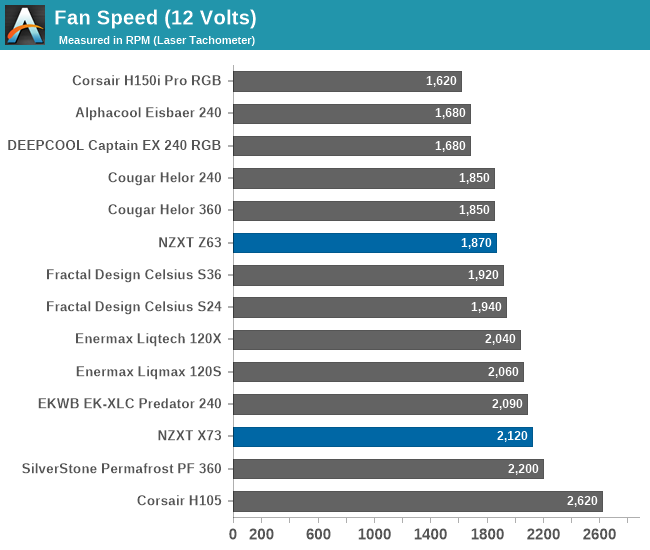
The Z63 does come with one upside, however: with a sound pressure level of 39.8 dB(A), noise levels are notably lower than those from the X73.
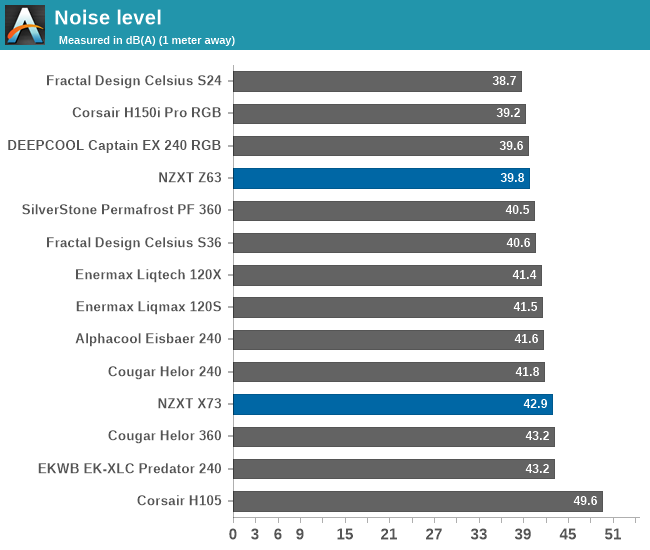
Testing Results, Low Fan Speed
Using a PWM voltage regulator, we reduced the speed of the fans manually down to half their rated speed. At this setting, the 120 mm fans of the X73 and the 140 mm fans of the Z63 rotate at 1240 RPM and 1050 RPM respectively. The pumps were also connected on the same power source, functioning properly at this low speed setting.

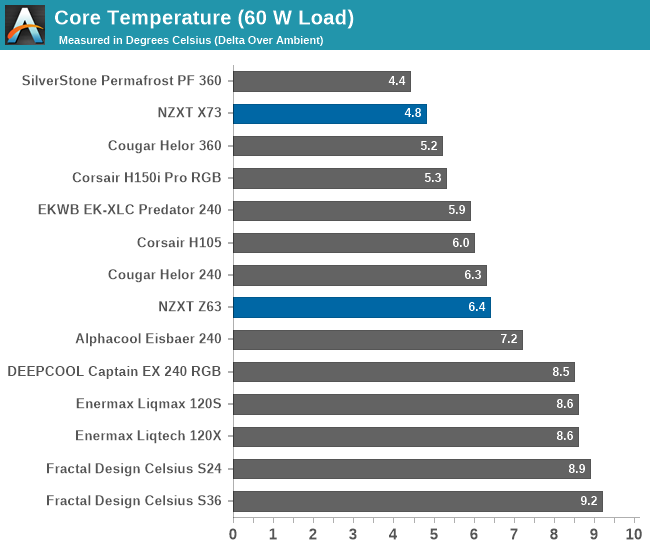
| Core Temperature, Constant Thermal Load (Low Fan Speed) |
NZXT’s X73 once again stands out with an average thermal resistance of 0.0812 °C/W, the best average figure that we have recorded from any AIO cooler to this date. The thermal resistance of the X73 is virtually stable regardless of the load with its pump and fans operating in this state, surpassing most other AIO coolers in any scenario.
However when we check our sound level meter, we measure a sound pressure of 37.4 dB(A), a relatively high figure compared to other coolers. That is mostly because of the high speed and high static pressure nature of the fans, which creates aerodynamic noise. That said, the cooler can certainly operate at lower noise levels if connected to a dynamic control system, such as any modern motherboard that would allow full control over the speed of its fans and pump, but at the obvious expense of thermal performance.
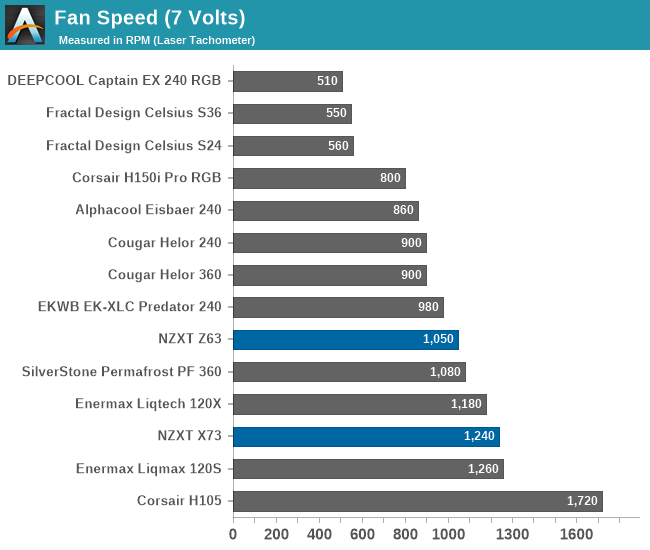
The NZXT Z63 also performs well in our low-speed testing. With an average thermal resistance of 0.0935 °C/W, the 280 mm cooler manages to get dangerously close to many larger AIO coolers, and even surpasses a few of them. Although the mediocre results we got from low load testing initially misguided us into believing that the Z63 will fall far behind the competition, it proved to be very efficient at handling heavy loads. Meanwhile the 35.1 dB(A) of noise coming from the cooler should be tolerable for the majority of home PC users.
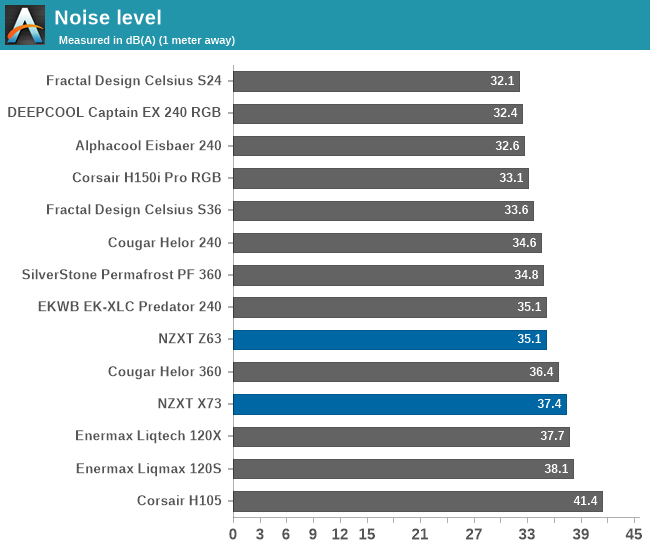
Thermal Resistance VS Sound Pressure Level
During our thermal resistance vs. sound pressure level test, we maintain a steady 100W thermal load and assess the overall performance of the coolers by taking multiple temperature and sound pressure level readings within the operating range of the stock cooling fans. The result is a graph that depicts the absolute thermal resistance of the cooler in comparison to the noise generated. For both the sound pressure level and absolute thermal resistance readings, lower figures are better.
This graph reveals very interesting information. We can see that the NZXT X73 surpasses the absolute thermal resistance of all other 360 mm radiator coolers and also is quieter than Cougar’s Helor and the older Celsius S36. But it is slightly louder than the PF 360 at any given level of thermal performance.
More interesting, perhaps, is the NZXT Z63. It may trail the thermal resistance of the X73 by a small margin, but it manages the same level of thermal performance with significantly less noise. The thermal resistance to sound pressure level curve is steep and suggests that the Z63 can, at the expense of higher noise levels, even outperform the 360 mm coolers if paired with more powerful 140 mm fans.


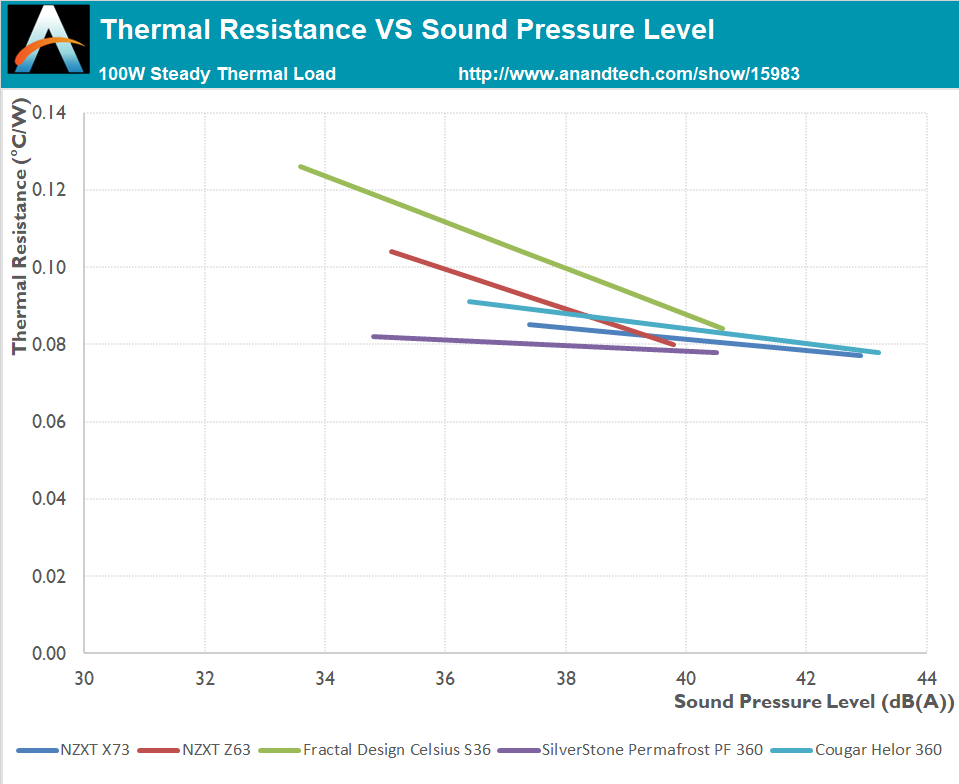








61 Comments
View All Comments
brontes - Wednesday, August 19, 2020 - link
When it comes to mixing water and electronics, nobody wants to mess around with unproven stuff.It works the same way in custom loop stuff. There are as many rebadges of the
asetek aio as there are the D5 and DDC custom loop pumps. https://laing-thermotech.com/industrial-commercial...
But I agree, after time the mix and match of each part provides a known quantity in terms of performance, which isn't bad. But it makes for a boring review. Kind of like the Lego style designs in midrange ssds.
brontes - Wednesday, August 19, 2020 - link
edit: Retest all these aios using the same fans instead of the included and I bet they would perform within margin of error of each other. Fan pairings make a much more apparent difference on a rad than a standard heatsink.Guspaz - Wednesday, August 19, 2020 - link
For that matter, any cooler review without noise-normalized testing is useless (who cares how well it performs at max fan speed, those aren't the same noise levels and can't be compared) and this review didn't include that. It does mitigate this with the thermal resistance versus sound pressure test at the end, but that doesn't really provide a convenient point of comparison, nor does it tell the user "How hot will my CPU run at a reasonable sound level."rpg1966 - Thursday, August 20, 2020 - link
It's extraordinary that their cooler tests don't have a simple x-y chart of noise/dB versus CPU temp.E.Fyll - Thursday, August 20, 2020 - link
Page 4, last section.TelstarTOS - Thursday, August 20, 2020 - link
of only 4 models.alufan - Thursday, August 20, 2020 - link
I dont understand why they dont test them all at a set RPM forget all the pwm stuff wire them i via a fan controller and set them at say 800 RPM and see which actually shifts the heat, my Custom loop rarely hits anything more than 750 rpm and my CPU is under 50deg C no matter what I do with itGuspaz - Thursday, August 20, 2020 - link
RPM is irrelevant. Performance at a fixed noise level is what matters, because a cooler that comes with noisy fans and a cooler that comes with quiet fans shouldn’t be weighted equally if they cool as well at the same RPM.TelstarTOS - Thursday, August 20, 2020 - link
"any cooler review without noise-normalized testing is useless"QFT. This review is almost useless and subpar for AT usual level of completness.
GNUminex_l_cowsay - Wednesday, August 19, 2020 - link
Don't retest these AIOs with the same fan. The brands that include inappropriate fans with their AIOs deserve the consequences of their poor decisions.